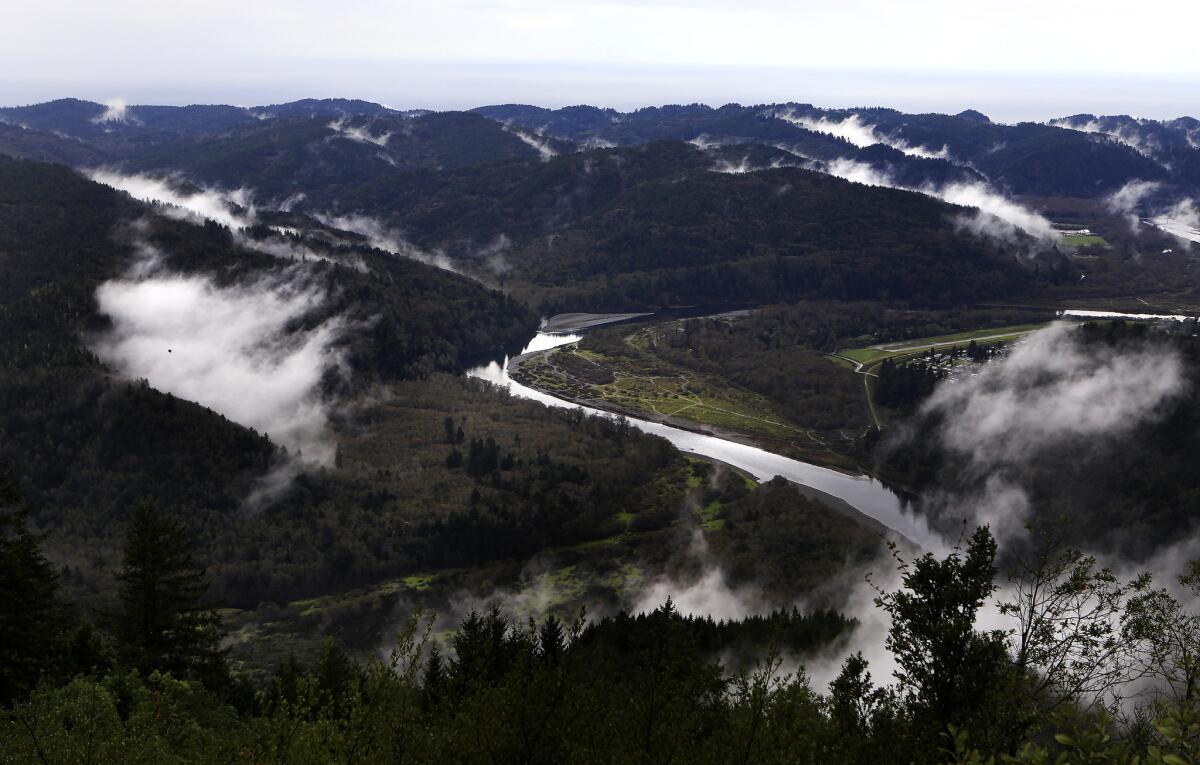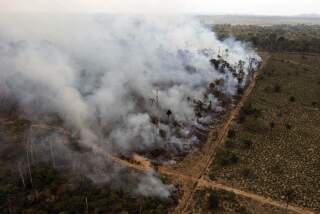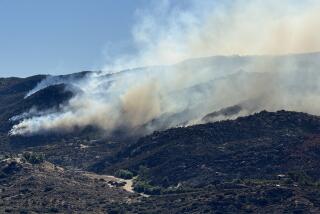Yurok tribe hopes California’s cap-and-trade can save a way of life

This winter, Yurok tribe forestry crews will be four-wheeling down muddy fire roads, hiking through steep, slippery brush and trekking across more than 20,000 acres of forest to count and measure trees.
Instead of preparing to sell lumber, as it has in the past, the state’s largest Indian tribe is taking stock of its firs, redwoods and tanoaks to make money in California’s cap-and-trade program.
By managing its forest near Redwood National Park for carbon storage instead of timber harvest, the tribe is generating credits to sell to oil companies and other businesses that must reduce greenhouse gas emissions as part of the state’s effort to slow climate change.
When trees are allowed to grow, they absorb more carbon dioxide from the air and store it in their trunks, branches and roots. That sequestered carbon, which would otherwise be contributing to global warming, is now a valuable commodity for landowners like the Yurok.
The Yurok tribe has sold millions of dollars’ worth of carbon credits, known as offsets, to some of the state’s biggest polluters. The tribe’s forestry program is one of more than two dozen operations across the nation that have generated offsets for California’s growing carbon market.
The initiative is giving the Yurok tribe a new way to make money while it improves wildlife habitat, expands its forestry staff and acquires land in its ancestral territory near the mouth of the Klamath River in Del Norte and Humboldt counties.
Driving the new activity is the state’s 2006 global warming law, AB 32, which aims to cut greenhouse gas emissions to 1990 levels by 2020. The state’s cap-and-trade program, which launched in 2012 for hundreds of the state’s top carbon emitters and is set to expand Jan. 1, is key to meeting that target.
Cap-and-trade sets a statewide limit on greenhouse gas emissions and requires companies to buy one permit, called an allowance, for each metric ton they emit. Allowances can be purchased in government-issued auctions or on California’s carbon market.
The amount of pollution permitted declines each year, making allowances more scarce and expensive over time and giving businesses an economic incentive to cut emissions.
Companies can use less-expensive carbon offsets — credits obtained by essentially paying others to reduce greenhouse gases — to cover up to 8% of their emissions. If used to their full potential, offsets could account for as much as half of the required pollution reductions over the next several years.
The California Air Resources Board issues offsets to businesses that destroy planet-warming refrigerants, to dairies that capture the potent greenhouse gas methane, and to landowners, such as the Yurok tribe, who commit for the next 100 years to manage their forest to pull more carbon dioxide out of the atmosphere.
“The value of preserving trees for 100 years is something that was unheard of from an economics perspective in the past,” said Timothy O’Connor, who directs the California Climate Initiative for the Environmental Defense Fund, a nonprofit advocacy group that supports the state’s cap-and-trade and offset programs. “This new dimension is enabling landowners to make decisions that are both good for the planet and good for their pocketbooks.”
Carbon offsets can also produce reductions outside of California and in industries that wouldn’t otherwise be required to cut emissions under the cap-and-trade regulations, such as livestock and forestry.
But critics of carbon offsets, including some environmental groups, say there is no way to know whether additional carbon stored in forests is a result of cap-and-trade or whether it would not have occurred otherwise.
The state Air Resources Board says its rigorous rules ensure that every carbon credit issued meets the law’s requirement that all reductions in greenhouse gas emissions be “real, permanent, quantifiable, verifiable and enforceable.”
The state’s 113-page protocol for forest offset projects details steps for measuring and calculating the amount of carbon dioxide that trees remove from the atmosphere and includes extensive monitoring, reporting and verification requirements.
In April, the state Air Resources Board issued the Yurok tribe more than 800,000 offset credits in one of the first forestry projects approved under cap-and-trade. At current market rates, they can be sold for around $9 a credit, making them worth several million dollars.
Nathan Voegeli, an attorney for the tribe, said it usually sells offsets directly to carbon emitters in large transactions. He declined to identify the buyers but said they include major oil companies.
“Sales are going on all the time,” he said. “They’re constantly looking for credits.”
Yurok officials said the carbon projects make sense for the tribe because they align with its other goals: increasing the tribe’s land base and restoring forest near the Klamath River and its tributaries, which improves water quality and its prized salmon fishery.
The Yurok tribe does not own most of the land that makes up its reservation, which extends in a narrow strip from the Pacific Ocean up 44 miles of the Klamath. About half of the reservation is owned by timber companies that have typically logged and replanted the forest at about 50-year intervals.
The tribe is using proceeds from offset sales to help pay for land acquisitions, including a 2011 purchase of more than 22,000 acres from Green Diamond Resource Co., a Seattle-based lumber operation. Tribal leaders are planning additional carbon sequestration projects that they hope will enable them to buy more land in and around the reservation.
To be issued carbon credits, the tribe must demonstrate that improved management will increase carbon stored in the forest. For each metric ton of carbon dioxide saved that would have been lost to the atmosphere under previous practices, the tribe earns one credit.
Though the tribe is allowed to harvest some timber from its carbon project areas, it must factor logging into its calculations.
“You only have so much growth, so it’s a balancing act,” said James Erler, who heads the tribe’s forestry program.
To estimate how many carbon molecules are stored in tree trunks, roots and surrounding vegetation, crews have adapted techniques that lumber companies use to take stock of timberlands. Tribe technicians use measuring tapes, clinometers and other hand-held instruments to gauge the height, diameter and growth rate of trees in an extensive grid of sampling plots throughout the forest.
The measurements are verified by a third party. Every few years, crews must return to the same locations — marked with numbered stakes — and inventory trees again to calculate how much growth is occurring and how many credits can be sold.
Like any investment, a carbon project requires upkeep. That often means harvesting less timber to let trees grow older and larger. To boost forest productivity, crews may have to thin some species of trees and maximize carbon storage by others.
Although towering firs and redwoods might look as if they could hold more carbon, smaller hardwoods, such as tanoaks, have greater potential, Erler said, “because they grow fast and dense.”
The investment also comes with risks. A wildfire or disease, such as sudden oak death syndrome, could deal a major financial blow to the tribe’s project. As a sort of insurance policy, the tribe is required to place a portion of its carbon credits in a buffer account where they cannot be sold.
Yurok tribe Chairman Thomas O’Rourke Sr. said the tribe has embraced carbon projects because they “maximize both revenue and the ability to preserve the forest. To not only do our part with global warming, but to preserve our way of life so that our future generations can see the pristine forest that our parents’ grandparents saw.”







